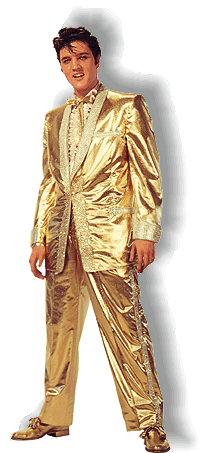 www.elvis.com
www.elvis.com
|
Girls! Girls! Girls! - 1 - 3
Elvis's eleventh film was "Girls! Girls! Girls!" (Paramount, 1962).
Elvis reported to the studio on March 26, 1962.
With the huge success of "Blue Hawaii" (Paramount 1961), producer
Hal Wallis had decided to promote Elvis as an entertainer rather
than the rebel actor, reminiscent of James Dean, as Elvis had been
seen in "King Creole" (Paramount 1958). Thus another script was set
in scenic Hawaii.
The working titles for "Girls! Girls! Girls!" had been "A Girl In
Every Port," "Welcome Aboard," "Jambalaya," and "Gumbo Ya-Ya,"which
is said to be a Creole expression for "everybody talks at once."
The story was written by Allan Weiss, who also worked on the Elvis
films "Blue Hawaii", "Fun In Acapulco", "Paradise, Hawaiian Style",
"Easy Come, Easy Go" and "Roustabout." For "Roustabout" he received
a 1965 nomination from the Writer's Guild of America for Best
Written American Musical. Also working on the script was Edward
Anhalt, who won Academy Awards for his screenplays for "Becket" and
"Panic In the Streets."
He received an Academy Award nomination for "The Sniper."
On March 26, 1962, Elvis began three days of soundtrack recording at
Radio Recorders in Hollywood.
The title song "Girls! Girls! Girls" had been written in 1960 by
Leiber and Stoller for The Coasters. Elvis was not pleased with the
direction his career was headed and wasn't pleased with the prospect
of singing to shrimp or any other sea creatures ("Song of the
Shrimp" is a soundtrack song). However, one great classic Elvis song
came from this film's soundtrack. It was the Otis Blackwell and
Winfield Scott composition "Return To Sender." The song had not been
written for this movie, but when Colonel Parker heard it he knew it
would be perfect for Elvis and made sure he heard it as well. And in
the scene of the movie when Elvis sings the song, you can see in his
movements the influence of one of his favorite entertainers, Jackie
Wilson.
Two of the songs Elvis recorded in the soundtrack sessions were not
used in the film. It was the group The Amigos' version of "Mama"
that was used instead of Elvis's rendition. The group consisted of
Jose Vadiz, Pedro Berrios, Miguel Alcade and Felix Melendes.
"Plantation Rock" was cut as well.
With the music recorded, it was time to go to Hawaii for the
location portions of shooting the film. Elvis wanted to go to Hawaii
by ship, however, a strike forced him to fly. The decision placed
the production behind schedule. Later, when Paramount sent a check
for two extra days of Elvis's time, Colonel Parker refused the
payment as it had been Elvis's reluctance to fly that had caused the
filming delay. The check was never cashed.
On April 7, 1962 , Elvis and his entourage arrived in Hawaii on Pan
Am flight #817. Elvis then took a helicopter ride to the Hawaiian
Village Hotel where he would stay. Approximately 8,000 fans were on
hand for his arrival and in the 100-yard walk between the helicopter
and the hotel he lost his yachting cap, his jewel-tipped tie clasp
and a diamond ring that he especially liked. The next day, a young
girl called the hotel and said that his ring had come off in her
hand and that she wished to return it. She did leave the ring at the
front desk of the hotel.
At this time Elvis was very much into karate and actively practicing
- breaking up to 40 boards a night. Hal Wallis put an end to it for
the druation of the production for fear that Elvis would break his
hand and hold up the production schedule.
Principal photography began on April 9, 1962. Shooting in Hawaii
included locations such as the Bumble Bee Tuna plant near Waikiki
Beach and the Ala Wai Yacht Harbor. On April 26, 1962 location
shooting was finished.
Elvis and the production team returned Hollywood where filming
resumed on Stage 5 at the Paramount Studios on May 1, 1962 .
Copyright © 2000-2021 Elvis Presley Enterprises, Inc. ALL RIGHTS RESERVED |

 www.elvis.com
www.elvis.com